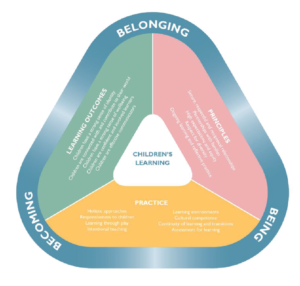The Framework puts children’s learning at the core and comprises three interrelated elements: Principles, Practice, and Learning Outcomes (see Figure 1). All three elements are fundamental to early childhood pedagogy and curriculum decision-making. Curriculum encompasses all the interactions, experiences, routines, and events, planned and unplanned, that occur in an environment designed to foster children’s learning and development. The emphasis in the Framework is on the planned or intentional aspects of the curriculum. Children are receptive to a wide range of experiences. What is included or excluded from the curriculum affects how children learn, develop, and understand the world. The Framework supports a model of curriculum decision-making as an ongoing cycle. The educators draw on their professional knowledge, including their in-depth knowledge of each child. Working in partnership with families, educators use the Learning Outcomes to guide their planning for children’s learning. In order to engage children actively in learning, educators identify children’s strengths and interests, choose appropriate teaching strategies, and design the learning environment. Educators carefully assess learning to inform further planning.
ELEMENTS OF THE FRAMEWORK
children's learning
The diversity in family life means that children experience belonging, being, and becoming in many different ways. They bring their diverse experiences, perspectives, expectations, knowledge, and skills to their learning.
Children’s learning is dynamic, complex, and holistic. Physical, social, emotional, personal, spiritual, creative, cognitive, and linguistic aspects of learning are all intricately interwoven and interrelated. Play is a context for learning that:
- allows for the expression of personality and uniqueness
- enhances dispositions such as curiosity and creativity
- enables children to make connections between prior experiences and new learning
- assists children to develop relationships and concepts
- stimulates a sense of wellbeing.
Children actively construct their own understandings and contribute to others’ learning. They recognise their agency, capacity to initiate and lead learning, and their rights to participate in decisions that affect them, including their learning.
Viewing children as active participants and decision-makers opens up possibilities for educators to move beyond pre-conceived expectations about what children can do and learn. This requires educators to respect and work with each child’s unique qualities and abilities.
Educators’ practices and the relationships they form with children and families have a significant effect on children’s involvement and success in learning. Children thrive when families and educators work together in partnership to support young children’s learning.
Children’s early learning influences their life chances. Wellbeing and a strong sense of connection, optimism, and engagement enable children to develop a positive attitude to learning. The Learning Outcomes section of the Framework provides examples of evidence of children’s learning and the educator’s role.
elements of the early years learning framework
This diagram shows the relationship between learning outcomes, principles and practices which centres on children’s learning. The three themes of Belonging, Being and Becoming are contained overlapping all of these elements.
